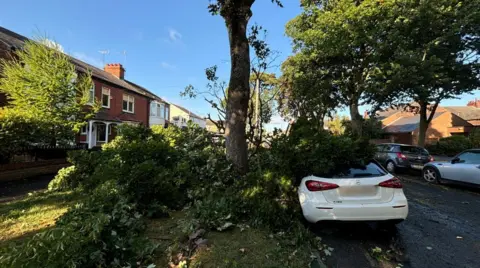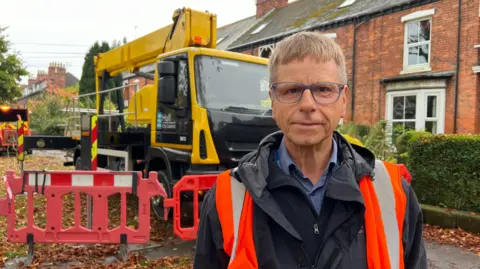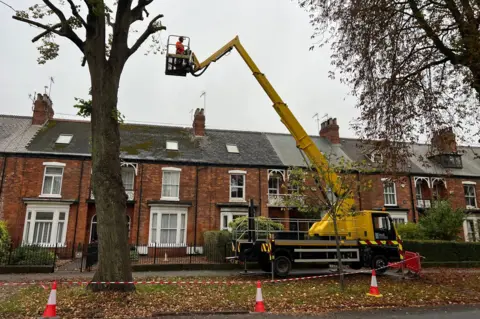As the country enters storm season, a common hazard will be falling trees. The BBC joins a team in Hull working daily to identify problems and prevent trees from causing a risk to life and damaging property.
In leafy Westbourne Avenue, a crane lifts a man towards the top of a tall tree.
He makes a careful cut with a chainsaw and a branch falls to the ground.
On the street below, workers wearing helmets and hi-vis jackets feed dead wood and leaves into a chipper.
Residents here are used to trees falling in high winds – cars were damaged during storms in May and August – and the work is designed to prevent more going the same way.
"The weather is getting stormier and windier, we have to be more vigilant" says Charles Quinn, the city councillor with responsibility for the environment.
"What this proactive work does is make sure that trees are safe and it reduces the number of branches that come down in storms."

There are 60,000 trees around Hull, almost half on street verges, and three or four teams work day-in, day-out to manage them.
They inspect trees for safety issues, including by using ultrasound technology to check their health internally. Diseased, damaged and diverging trees (where branches cross) are earmarked for action.
Routine work can include branch removal, canopy reduction and pollarding – a method of pruning that keeps trees smaller than they would naturally grow.
In more extreme cases, a tree can be removed if there is thought to be a significant danger.
"Removal is usually the last option," says Andrew Wilson, the open space development officer at the council.
"We have some historic plantings, like here in the Avenues, where they were created to have that avenue impact, and they've done their job for many years.
"Obviously they come to the end of their lives eventually, and we have a planting programme to make sure we have sustainable verges."

The majority of the work involves keeping trees to a manageable size and removing dead and decaying wood, which keeps them healthy.
"The other work is what they call crown lifting, where you're taking lower branches off so people's visibility and sight lines can be clear," Mr Wilson says.
Autumn can be a particularly dangerous time because storms tend to hit when trees are still in full leaf, which makes them act like "a sail" in the wind.
"If the ground's wet then the roots can't hold on as well, so we do get more that come down," he adds.
"Drier weather, we tend to get more broken branches than actual trees falling down."
Despite the proactive work, trees will, inevitably, fall.
"We're not all-seeing, all-doing; the reason we don't have as many [falling] is because we're doing this proactive work.
"Trees do have their weak fissures that we're not aware of and branches come down."

In Westbourne Avenue, tree surgeon Craig Davis is part of a gang of 14 working to make the trees safe.
"It's a physical job," he says. "It does take its toll, especially in the summer – you're wearing massive amounts of PPE.
"A lot of us prefer it when it cools off this time of year."
The workers try not to waste the material they chop down and the chippings they make are destined for biomass boilers.
"It makes it sustainable," he says. "There's a benefit for somebody right along the line."
During storms he could be called out at any time of the day or night.
"It's a thing that you can't predict, so there's somebody on call 24 hours a day, 365 days a year.
"The tree officers go out and assess what the damage has been in the storm. We'll get a phone call and we'll go out and execute whatever we have to do to make the tree safe."
'Slowly adapting'
There are fears that climate change could make storms worse, though the evidence is inconclusive.
Nevertheless, the council is adapting its planting regime to cope with issues such as higher temperatures.
"Trees have suffered," says Mr Wilson. "Two years ago, we had temperatures topping 40C. That has had a long-term effect on some of our trees.
"They are slow to react, but you do see the die-back coming, where roots have died back and you're seeing the experience on the top.
"It is part of climate change and as a result of that we are looking at the species that we plant. We are slowly adapting."
As for the trees in Westbourne Avenue, Mr Davis points out one where crowning work has been completed.
"None of the dead wood is going to fall out this winter," he says.
Listen to highlights from Hull and East Yorkshire on BBC Sounds, watch the latest episode of Look North or tell us about a story you think we should be covering here.

.jfif)
Post a Comment